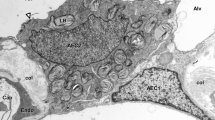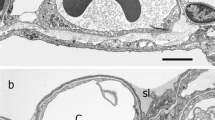Summary
The epithelium from the lungs of chicken embryos after incubation of 9 days had been studied in a Bisolvon containing culture-medium (cover-glass, monolayer- and organoid-culture). Bisolvon was added solved or insolved in a concentration of 10, 30, 100, or 300 γ per ml medium. The rate of growth determined from the number of cells and their mitoses per square had not been altered with Bisolvon concentrations as much as 100 γ per ml medium. With higher Bisolvon concentrations fibroblast mitosis number diminished in some experiments. In the cover-glass- and monolayer cultures a special type of cells is developing after Bisolvon treatment. These cells resemble the „Nischen“-cells (granular pneumocytes). If Bisolvon is added in a concentration of 300 γ per ml medium a damage of the epithelial cells is obvious with the electron microscope. In the organoid-cultures numerous lysosome-like organelles are found in relation to the dose of Bisolvon. The ability of the epithelial cells to develop towards „Nischen“-cells (cover-glass or monolayer-cultures) respectively towards the bronchial epithel cells (piece-cultures) is discussed.
We suppose Bisolvon acts at the lysosomal apparatus of bronchial epithelium and at the antiatelectase factor (AAF) of the granular pneumocytes.
Zusammenfassung
Deckglas-, Monolayer- und Stückkulturen vom Lungenepithel 9tägiger Hühnerembryonen wurden nach Zusatz von Bisolvon elektronenmikroskopisch untersucht. Diese Substanz wurde entweder fein verteilt oder gelöst den Kulturen in einer Menge von 10, 30, 100 oder 300 γ/ml Medium zugesetzt. Das planimetrisch bestimmte Epithelwachstum verändert sich bis 100 γ Bisolvon/ml Medium auch nach mehreren Umsetzungen ebensowenig, wie die Zahl der Epithelzellen und Mitosen pro Flächeneinheit. Das Wachstum der Fibroblasten wird jedoch bei höherer Dosierung in manchen Versuchen gehemmt.
In den Deckglas- und Monolayer-Kulturen entwickeln sich unter Bisolvon Zellen, die den Nischenzellen in situ ähnlich sind.
Erst nach 300 γ Bisolvon/ml Medium läßt sich im Epithel elektronenmikroskopisch eine Zellschädigung nachweisen. In der Stückkultur entstehen zahlreiche lysosomenähnliche Einschlüsse, deren Inhalt dosisabhängig verändert wird. Die Fähigkeit der Zellen in Richtung auf Nischenzellen (Deckglas- bzw. Monolayer-Kultur) bzw. Bronchialepithelzellen (Stückkultur) zu differenzieren, wird diskutiert. Damit kann ein Angriffspunkt des Bisolvon am lysosomalen Apparat der Bronchialepithelzellen und am AAF in den Nischenzellen vermutet werden.
Similar content being viewed by others
Literatur
Buckingham, S., andM. E. Avery: Time of appearance of lung surfactant in the foetal mouse. Nature193, 688 (1962).
Burgi, H.: Erste klinisch-experimentelle Erfahrungen mit dem Mukolytikum Bisolvon. Schweiz. med. Wschr.95, 274 (1965).
De Duve, G., andR. Watteaux: Function of lysosomes. Ann. Rev. Physiol.28, 435 (1966).
Gieseking, R., u.V. Baldamus: Elektronenmikroskopische Befunde an der Bronchialschleimhaut nach Behandlung mit Bisolvon. Beitr. Klin. Tuberk.137, 1 (1968).
Klaus, M. H., O. K. Reiss, W. H. Tooley, G. Piel, andJ. A. Clements: Alveolar epithelial cell mitochondria as source of the surface active lung lining. Science137, 750 (1962).
Merker, H. J.: Elektronenmikroskopische Untersuchungen über die Wirkung von N-Cyclohexyl-N-methyl-(2-amino-3,5-dibrombenzyl)-ammonium-chlorid auf das Bronchialepithel der Ratte. Arzneimittel-Forsch.16, 509 (1966).
—— Das elektronenmikroskopische Bild der Schleimsekretion in der Nasenhöhle und ihre Beeinflussung durch Bisolvon. Dtsch. med. J.18, 552 (1967).
-- u.B. Zimmermann: Das elektronenmikroskopische Bild der Epithelzellen aus embryonalen Hühnerlungen in der Gewebekultur. Beitr. Klin. Tuberk. (Im Druck)
Novikoff, A. B., andN. Quintana: Golgi-Apparatus and lysosomes. Fed. Proc.23, 1023 (1964).
Pattle, R. E.: Surface tension and the lining of the lung alveoli. In: Advances in respiratory physiology. Ed. byC. G. Caro. London: E. Arnold Ltd., 1966.
Smith, R. E., andM. G. Farquhar: Lysosome function in the regulation of the secretory process in cells of the anterior pituitory gland. J. Cell Biol.31, 319 (1966).
Author information
Authors and Affiliations
Rights and permissions
About this article
Cite this article
Merker, H.J., Zimmermann, B. Elektronenmikroskopische Untersuchungen über die Wirkung von Bisolvon® auf das Lungenepithel von Hühnerembryonen in der Kultur. Beitr. Klin. Tuberk. 139, 170–182 (1969). https://doi.org/10.1007/BF02090946
Received:
Issue Date:
DOI: https://doi.org/10.1007/BF02090946




